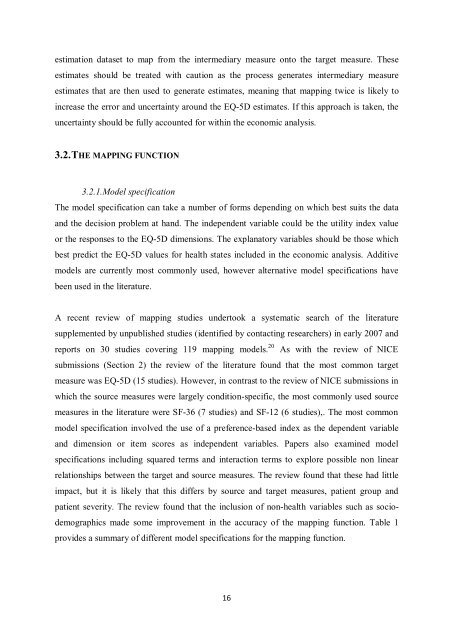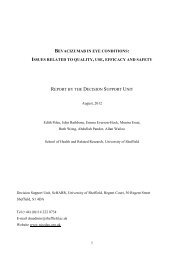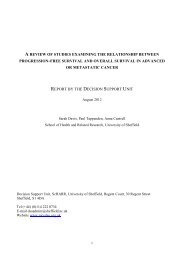the use of mapping methods to estimate health state utility values
the use of mapping methods to estimate health state utility values
the use of mapping methods to estimate health state utility values
Create successful ePaper yourself
Turn your PDF publications into a flip-book with our unique Google optimized e-Paper software.
estimation dataset <strong>to</strong> map from <strong>the</strong> intermediary measure on<strong>to</strong> <strong>the</strong> target measure. These<br />
<strong>estimate</strong>s should be treated with caution as <strong>the</strong> process generates intermediary measure<br />
<strong>estimate</strong>s that are <strong>the</strong>n <strong>use</strong>d <strong>to</strong> generate <strong>estimate</strong>s, meaning that <strong>mapping</strong> twice is likely <strong>to</strong><br />
increase <strong>the</strong> error and uncertainty around <strong>the</strong> EQ-5D <strong>estimate</strong>s. If this approach is taken, <strong>the</strong><br />
uncertainty should be fully accounted for within <strong>the</strong> economic analysis.<br />
3.2. THE MAPPING FUNCTION<br />
3.2.1.Model specification<br />
The model specification can take a number <strong>of</strong> forms depending on which best suits <strong>the</strong> data<br />
and <strong>the</strong> decision problem at hand. The independent variable could be <strong>the</strong> <strong>utility</strong> index value<br />
or <strong>the</strong> responses <strong>to</strong> <strong>the</strong> EQ-5D dimensions. The explana<strong>to</strong>ry variables should be those which<br />
best predict <strong>the</strong> EQ-5D <strong>values</strong> for <strong>health</strong> <strong>state</strong>s included in <strong>the</strong> economic analysis. Additive<br />
models are currently most commonly <strong>use</strong>d, however alternative model specifications have<br />
been <strong>use</strong>d in <strong>the</strong> literature.<br />
A recent review <strong>of</strong> <strong>mapping</strong> studies under<strong>to</strong>ok a systematic search <strong>of</strong> <strong>the</strong> literature<br />
supplemented by unpublished studies (identified by contacting researchers) in early 2007 and<br />
reports on 30 studies covering 119 <strong>mapping</strong> models. 20 As with <strong>the</strong> review <strong>of</strong> NICE<br />
submissions (Section 2) <strong>the</strong> review <strong>of</strong> <strong>the</strong> literature found that <strong>the</strong> most common target<br />
measure was EQ-5D (15 studies). However, in contrast <strong>to</strong> <strong>the</strong> review <strong>of</strong> NICE submissions in<br />
which <strong>the</strong> source measures were largely condition-specific, <strong>the</strong> most commonly <strong>use</strong>d source<br />
measures in <strong>the</strong> literature were SF-36 (7 studies) and SF-12 (6 studies),. The most common<br />
model specification involved <strong>the</strong> <strong>use</strong> <strong>of</strong> a preference-based index as <strong>the</strong> dependent variable<br />
and dimension or item scores as independent variables. Papers also examined model<br />
specifications including squared terms and interaction terms <strong>to</strong> explore possible non linear<br />
relationships between <strong>the</strong> target and source measures. The review found that <strong>the</strong>se had little<br />
impact, but it is likely that this differs by source and target measures, patient group and<br />
patient severity. The review found that <strong>the</strong> inclusion <strong>of</strong> non-<strong>health</strong> variables such as sociodemographics<br />
made some improvement in <strong>the</strong> accuracy <strong>of</strong> <strong>the</strong> <strong>mapping</strong> function. Table 1<br />
provides a summary <strong>of</strong> different model specifications for <strong>the</strong> <strong>mapping</strong> function.<br />
16





